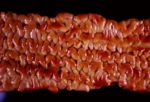Difference between revisions of "Johne's Disease"
| Line 32: | Line 32: | ||
In the later phases of infection, the disease is characterised by profuse, watery 'pipe-stem' diarrhoea and weight loss despite maintaining a good appetite. The disease is progressive and advanced cases may develop submandibular or ventral oedema due to a protein losing enteropathy. | In the later phases of infection, the disease is characterised by profuse, watery 'pipe-stem' diarrhoea and weight loss despite maintaining a good appetite. The disease is progressive and advanced cases may develop submandibular or ventral oedema due to a protein losing enteropathy. | ||
| + | |||
| + | The disease is similar in goats and sheep except diarrhoea is not a feature. | ||
==Pathogenesis== | ==Pathogenesis== | ||
| Line 40: | Line 42: | ||
==Gross Pathology== | ==Gross Pathology== | ||
| − | The infected host appears emaciated. | + | The infected host appears emaciated. Fat is pale and oedematous, and only present in small amounts. |
| + | Signs are confined to the terminal [[Small Intestine - Anatomy & Physiology|small intestine]] (especially the [[Ileum - Anatomy & Physiology|ileum]]) but are characteristic. The mucosal surface is diffusely thickened with transverse, corrugated rugae. Infected animals may also have enlarged mesenteric lymph nodes. | ||
| − | + | [[Image:johnes disease proliferative ileitis.jpg|thumb|right|150px|Proliferative ileitis in Johnes disease (Courtesy of Bristol BioMed Image Archive)]] | |
| − | |||
| − | |||
| − | |||
| − | |||
==Histologically== | ==Histologically== | ||
There are many large macrophages (epithelioid macrophages) in mucosa, submucosa and lymph nodes. | There are many large macrophages (epithelioid macrophages) in mucosa, submucosa and lymph nodes. | ||
| − | The mesenteric lymph nodes are pale and enlarged (though not necrotic), and the lamina propria is infiltrated by sheets of macrophages with some lymphocytes. | + | The mesenteric lymph nodes are pale and enlarged (though not necrotic), and the lamina propria is infiltrated by sheets of macrophages with some lymphocytes. Acid-fast bacteria are found in the macrophages and giant cells, and this is detected by Ziehl-Neelson stain. |
| − | Acid-fast bacteria are found in the macrophages and giant cells, and this is detected by Ziehl-Neelson stain. | ||
Bacteria act like foreign bodies producing a type IV hypersensitivity reaction. | Bacteria act like foreign bodies producing a type IV hypersensitivity reaction. | ||
Revision as of 15:50, 7 August 2010
| This article is still under construction. |
| Also known as: | Paratuberculosis |
Description
Johne's Disease is a contagious and chronic disease of ruminants caused by Mycobacterium avium subsp. paratuberculosis. Affected species include cattle, sheep, goats and camelids. The pathogen primarily affects the small intestine and is responsbile for severe economic losses due to culling losses and reduced reproductive performance and milk production. Calves are most commonly affected by this condition, and can be infected via a number of routes.
Pathogenesis
MAP is primarily spread through herds via faecal-oral transmission, contaminated water, in utero and through infected milk and colostrum.
There are three stages of infection in Johne's disease.
Stage 1: This often goes unnoticed, as it is subclinical. It typically affects animals less than two years of age, and will advance to stage II, only a few months later.
Stage 2: This is again a subclinical infection, usually affecting older heifers, or young adults. Infected animals are apparently healthy, but are shedding infection within their manure, infecting the environment.
Stage 3: Advanced infection. Animals will show clear clinical signs, including weight loss, decreased milk production, and a severe reduction in appetite.
Animals with advanced stage 3 will appear gaunt, and the meat is no longer deemed fit for human consumption. Once the disease is present in the herd, it is ver difficult to get rid of it.
Clinical Signs
There is a long incubation period between infection and the development of clinical signs; this may range from a year to several years. Animals may be affected subclinically before overt clinical signs are displayed, displaying reduced milk production, reduced reproductive performance and increased susceptibility to infection or disease.
In the later phases of infection, the disease is characterised by profuse, watery 'pipe-stem' diarrhoea and weight loss despite maintaining a good appetite. The disease is progressive and advanced cases may develop submandibular or ventral oedema due to a protein losing enteropathy.
The disease is similar in goats and sheep except diarrhoea is not a feature.
Pathogenesis
Organisms penetrate the M-cells of the Peyer's patches. Mycobacteria invade macrophages and cause a granulomatous inflammatory response. Death may result from: damage to the mucosa, not absorbing nutrients, or inflammatory loss of protein.
Gross Pathology
The infected host appears emaciated. Fat is pale and oedematous, and only present in small amounts. Signs are confined to the terminal small intestine (especially the ileum) but are characteristic. The mucosal surface is diffusely thickened with transverse, corrugated rugae. Infected animals may also have enlarged mesenteric lymph nodes.
Histologically
There are many large macrophages (epithelioid macrophages) in mucosa, submucosa and lymph nodes. The mesenteric lymph nodes are pale and enlarged (though not necrotic), and the lamina propria is infiltrated by sheets of macrophages with some lymphocytes. Acid-fast bacteria are found in the macrophages and giant cells, and this is detected by Ziehl-Neelson stain.
Bacteria act like foreign bodies producing a type IV hypersensitivity reaction. Sheep have two different forms: 1. Paucibacillary; many T cells, and few bacilli.
2. Multibacillary: Many macrophages, many bacilli in macrophages, and few lymphocytes.
Diagnosis
Diagnosis is by; Histology, Serological tests, ELISA and AGID.
60% of cases have lesions in colon and rectum and can be diagnosed by rectal biopsy.
